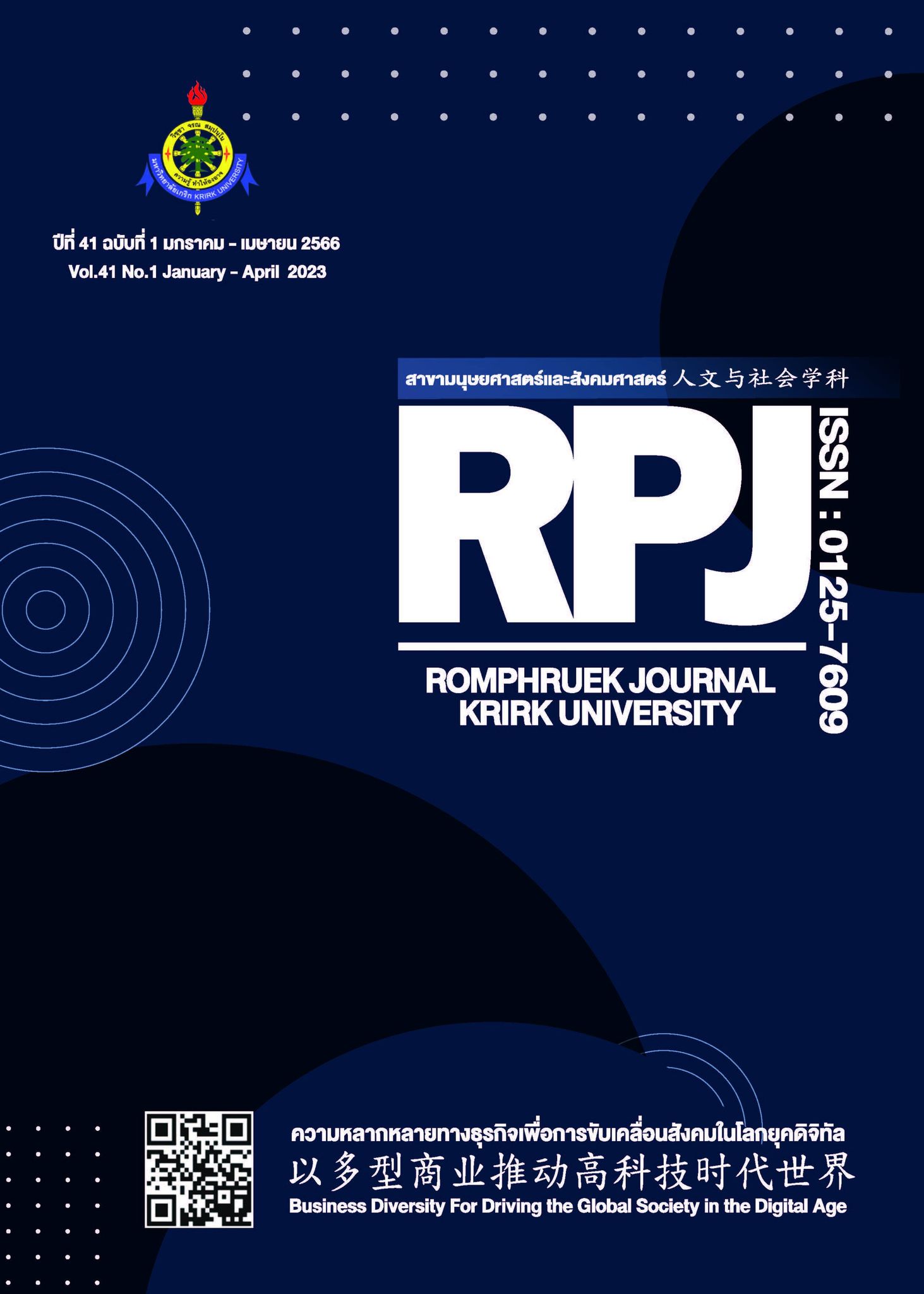Influence of Socially Responsible Leadership and Stakeholders’ Perception of Corporate Social Responsibility on Corporate Image of Don Mueang International Airport
Main Article Content
Abstract
The objectives of this research were to 1) identify the relationship among socially responsible leadership, stakeholders’ perception of corporate social responsibility and corporate image of Don Mueang International Airport, 2) analyze the influence of socially responsible leadership on corporate image of Don Mueang International Airport, and to 3) analyze the influence of socially responsible leader and stakeholders’ perception of corporate social responsibility on corporate image of Don Mueang International Airport. 394 Don Mueang International Airport’s stakeholders were chosen as samples for this study using quota and judgmental sampling method.
The results found that the correlation coefficient among observable variables were 0.276-0.860 with a significant level at each variable. According to the structural equation modeling, it was found that socially responsible leadership had a statistically significant influence on the respondents’ perceptions of corporate social responsibility and the variance predicted by socially responsible leadership was 50.6 percent.. Furthermore, the socially responsible leadership had direct influence on corporate image, and had indirect influence via the respondents' perceptions of corporate social responsibility at statistical significance, and variance predicted to corporate image was 64.2 percent. Finally, the respondents’ perception of corporate social responsibility had a significant direct effect to corporate image.
Article Details

This work is licensed under a Creative Commons Attribution-NonCommercial-NoDerivatives 4.0 International License.
Every article published in the Romphruek Journal of the Humanities and Social Sciences is the opinion and point of view of the authors. Thery're not the viewpoint of Krirk University or the editored department. Any part or all of the articles for pablication must be clearly cited.
References
กนกกาญจน์ ปานเปรม. (2558). แนวทางการพัฒนาคุณภาพการบริการของท่าอากาศยานดอนเมือง (ในมิติด้านการตอบสนองความต้องการต่อผู้โดยสารและในด้านการดูแลเอาใจใส่ต่อผู้โดยสาร). วารสารดุษฎีบัณฑิตทางสังคมศาสตร์ (ฉบับมนุษยศาสตร์และสังคมศาสตร์), 5(1), 30-40.
จันทวัลย์ สุ่นสวัสดิ์ วรพงศ์ ภูมิบ่อพลับ และวิญญู วีรยางกูร. (2563). รูปแบบการบริหารจัดการกิจกรรมเชิงพาณิชย์ของท่าอากาศยานดอนเมืองและท่าอากาศยานสุวรรณภูมิ. วารสารวิชาการมหาวิทยาลัยราชภัฏภูเก็ต, 16(1), 1-24.
ธนภัทร สุวรรณมณี และพิพัฒน์ นนทนาธรณ์. (2563). อิทธิพลของภาวะผู้นำการปฏิรูปและความรับผิดชอบต่อสังคมที่ส่งผลต่อภาพลักษณ์องค์การ: กรณีศึกษาพนักงานบริษัท อินเตอร์คลีนนิ่งซัพพลายส์ จำกัด. วารสารสมาคมนักวิจัย, 25(2), 162-175.
บริษัท ท่าอากาศยานไทย จำกัด (มหาชน). (2565ก). รายงานการพัฒนาอย่างยั่งยืน ประจำปี 2564. กรุงเทพฯ : ทอท.
บริษัท ท่าอากาศยานไทย จำกัด (มหาชน). (2565ข). รายงานประจำปี 2564. กรุงเทพฯ : ทอท.
พระราชบัญญัติการท่าอากาศยานแห่งประเทศไทย พ.ศ. 2522. (2522, มีนาคม 2). ราชกิจจานุเบกษา, 96 (29 ก) ฉบับพิเศษ, 1-23.
พิพัฒน์ นนทนาธรณ์. (2558ก). ปัจจัยเชิงสาเหตุของภาวะผู้นำที่รับผิดชอบต่อสังคมที่มีอิทธิพลต่อภาพลักษณ์องค์การของท่าอากาศยานสุวรรณภูมิ. วารสารสมาคมนักวิจัย, 20(2), 48-58.
พิพัฒน์ นนทนาธรณ์. (2558ข). ภาวะผู้นำเชิงปฏิบัติการ. (พิมพ์ครั้งที่ 2). กรุงเทพฯ : ศูนย์ผู้นำธุรกิจเพื่อสังคม.
พิพัฒน์ นนทนาธรณ์. (2559ก). การจัดการความรับผิดชอบต่อสังคมขององค์การ. (พิมพ์ครั้งที่ 2). กรุงเทพฯ : ศูนย์ผู้นำธุรกิจเพื่อสังคม.
พิพัฒน์ นนทนาธรณ์. (2559ข). อิทธิพลของภาวะผู้นำที่รับผิดชอบต่อสังคม การรับรู้ของผู้มีส่วนได้ส่วนเสียด้านความรับผิดชอบต่อสังคมขององค์การที่ส่งผลต่อต่อภาพลักษณ์องค์การของท่าอากาศยานเชียงใหม่. วารสารสมาคมนักวิจัย, 21(2), 202-212.
พิพัฒน์ นนทนาธรณ์. (2561). อิทธิพลของภาวะผู้นำที่รับผิดชอบต่อสังคม การรับรู้ของผู้มีส่วนได้ส่วนเสียด้านความรับผิดชอบต่อสังคมขององค์การที่ส่งผลต่อภาพลักษณ์องค์การของท่าอากาศยานแม่ฟ้าหลวง เชียงราย. วารเกษตรศาสตร์ธุรกิจประยุกต์, 12(17), 73-88.
Arendt, S. & Brettel, M. (2010). Understanding the influence of corporate social responsibility on corporate identity, image, and firm performance. Management Decision, 48(10), 1469-1492.
Carroll, Archie B. and Ann K. Buchholtz. (2006). Business and Society (6th ed.). USA : Thomson South-Western.
Carroll, Archie (Ed.). (1977). Managing Corporate Social Responsibility. Boston : Little, Brown and Company.
Cheney, G., & Vibbert, S. L. (1987). Corporate Discourse: Public relations and issue management. In F. M. Jablin, L. L. Putnam, K. H. Roberts, & L. W. Porter (Eds.), Handbook of Organizational Communication: An Interdisciplinary Perspective. Newbury Park, CA : Sage.
Czerniachowicz, Barabra, Andrzej Lis, & Anna Wieczorek-Szymanska. (2017). The relationships between leadership and corporate social responsibility: Systematic literature review. Journal of Corporate Responsibility and Leadership, 4(3), 9-23.
Dutton, J. E., & Dukerich, J. M. (1991). Keeping an eye on the mirror: Image and identity in organizational adaptation. Academy of Management Journal, 34(3), 517-554.
Dutton, J., E., Dukerich, J. M., & Harquail, C. V. (1994). Organizational images and member identification. Administrative Science Quarterly, 39(2), 239-263.
Hooper, Daire, Joseph Coughlan & Michael R. Mullen. (2008). Structural Equation Modeling: Guidelines for Determining Model Fit. Electronic Journal of Business Research Methods, 6(1), 53–60.
Hsu, Shu-Ling. (2018). The effects of corporate social responsibility on corporate image, customer satisfaction and customer loyalty. The International Journal of Social Sciences and Humanities Invention, 5(5), 4693-4703.
Karacsony, Peter. (2020). Analyzing the relationship between leadership style and corporate social responsibility in Hungarian Small and Medium-sized Enterprises. Acta Polytechnica Hungarica, 17(7), 183-198.
Ko, Eunju, Charles R. Taylor, Udo Wagner, & Hyun Ah Ji. (2008). Relationship among CEO image, corporate image and employment brand value in fashion industry. Journal of Global Academy of Marketing Science, 18(4), 307-331.
Kotler, Philip, & Nancy Lee. (2005). Corporate Social Responsibility. New Jersey : John Wiley & Sons.
Kotler, Philip, & Nancy Lee. (2009). Up and Out of Poverty: The Social Marketing Solution. Upper Saddle River : Wharton School.
Leech, N. L., Barrett, K. C., & Morgan, G. A. (2005). SPSS for Intermediate Statistics: Use and Interpretation (2nd ed.). Mahwah, NJ : Lawrence Erlbaum Associates.
Moffitt, M. A. (1994). Collapsing and integrating concepts of ‘public’ and ‘image’ into a new theory. Public Relations Review, 20(2), 159-170.
Nonthanathorn, P. (2015). Causal factors of socially responsible leadership influencing on corporate image of Phuket International Airport. International Conference on Applied Business Research X, 20(2020), 677-685.
Pless, N. M. (2007). Understanding responsible leadership. Journal of Business Ethics, 74(2007), 437-456.
Porter, Michael E. & Kramer, Mark R. (2006). Strategy & Society: The Link between Competitive
Advantage and Corporate Social Responsibility. Harvard Business Review.Retrieved from https://hbr.org/2006/12/strategy-and-society-the-link-between-competitive-advantage-and-corporate-social-responsibility.
Porter, Michael E. & Kramer, Mark R. (2011). Creating Shared Value: How to reinvent capitalism and unleash a wave of innovation and growth. Harvard Business Review. HBR.ORG.Retrieved from https://www.academia.edu/33395554/HBR_ORG_JanuaRy_FeBRuaRy_2011_reprint_r1101C_Creating_Shared_Value_how_to_reinvent_capitalism_and_unleash_a_wave_of_innovation_and_growth.
Waldman, David A. (2007). Best Practices in Leading at Strategic Levels: A Social Responsibility Perspective in Jay A. Conger and Ronald E. Riggio, (Eds), The Practice of Leadership, San Francisco : Jossey-Bass.


